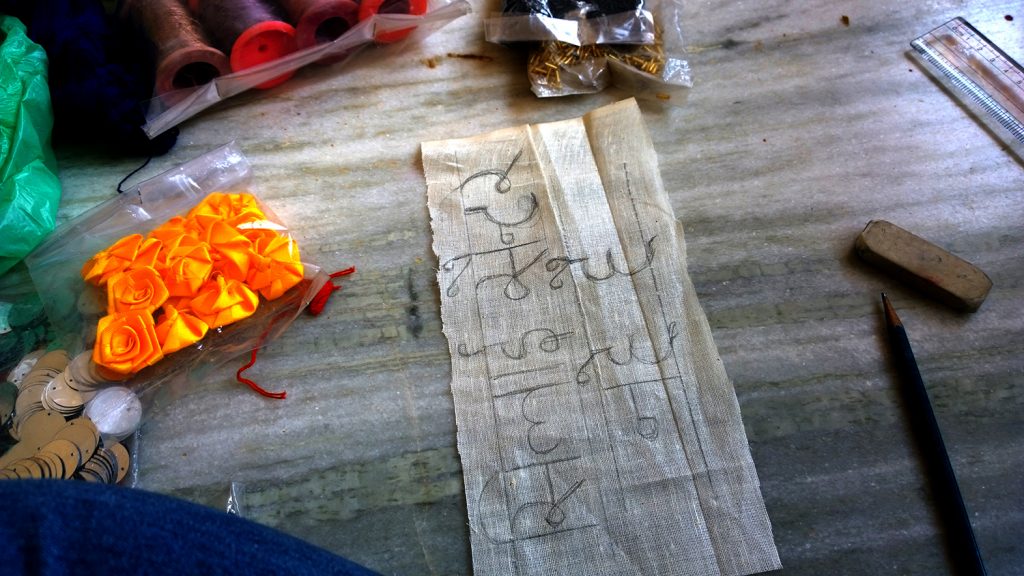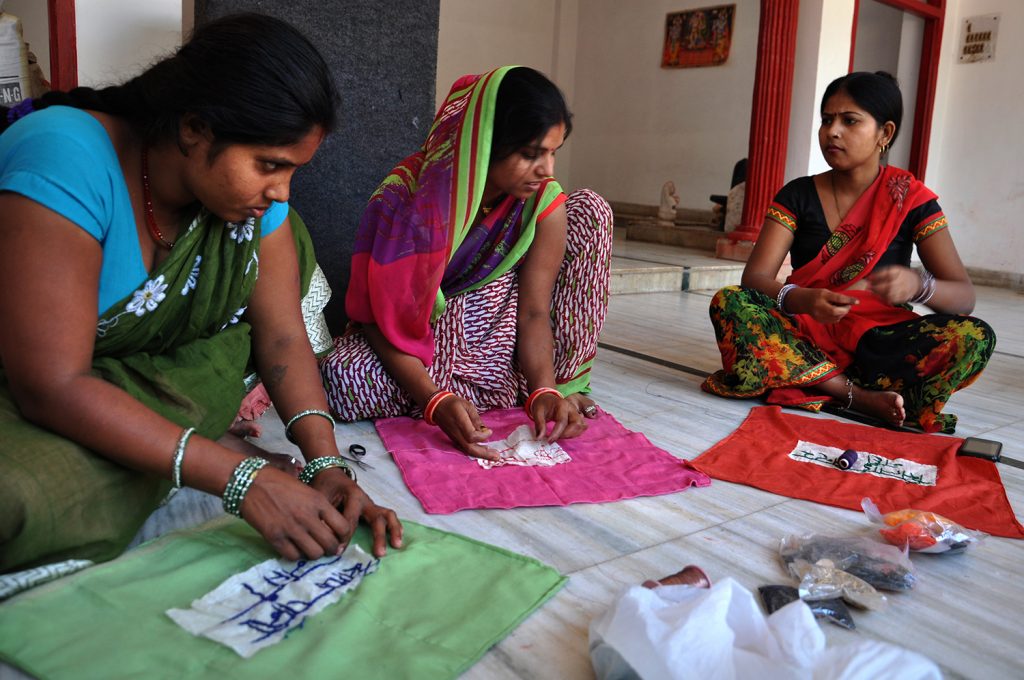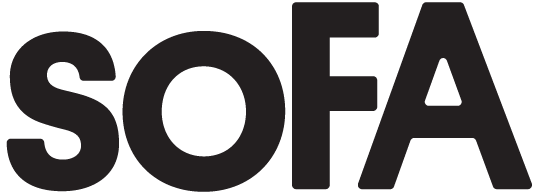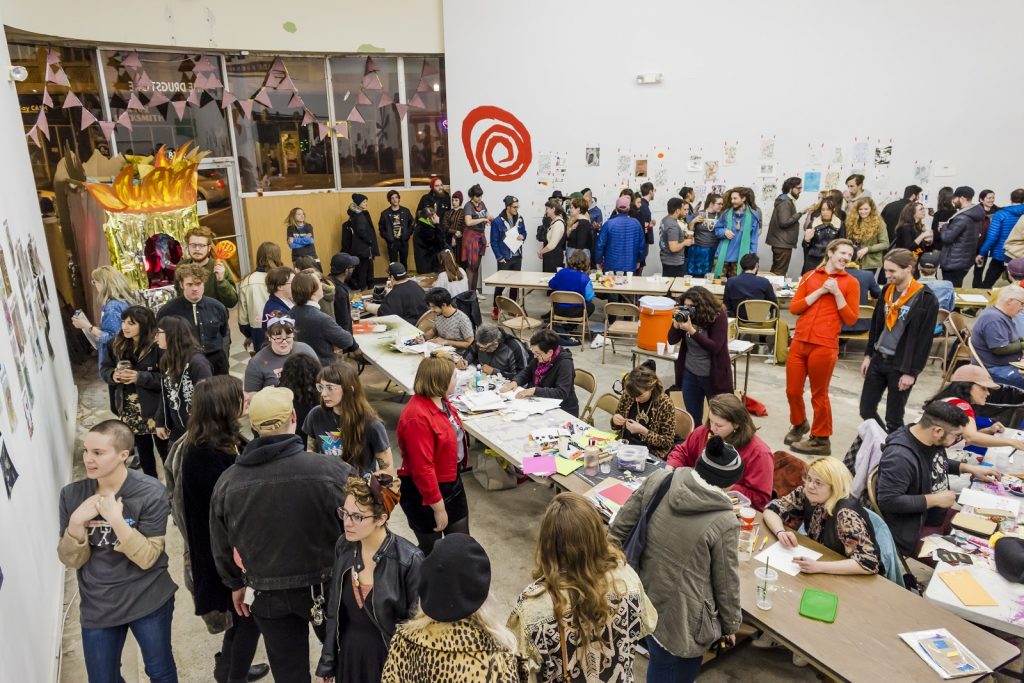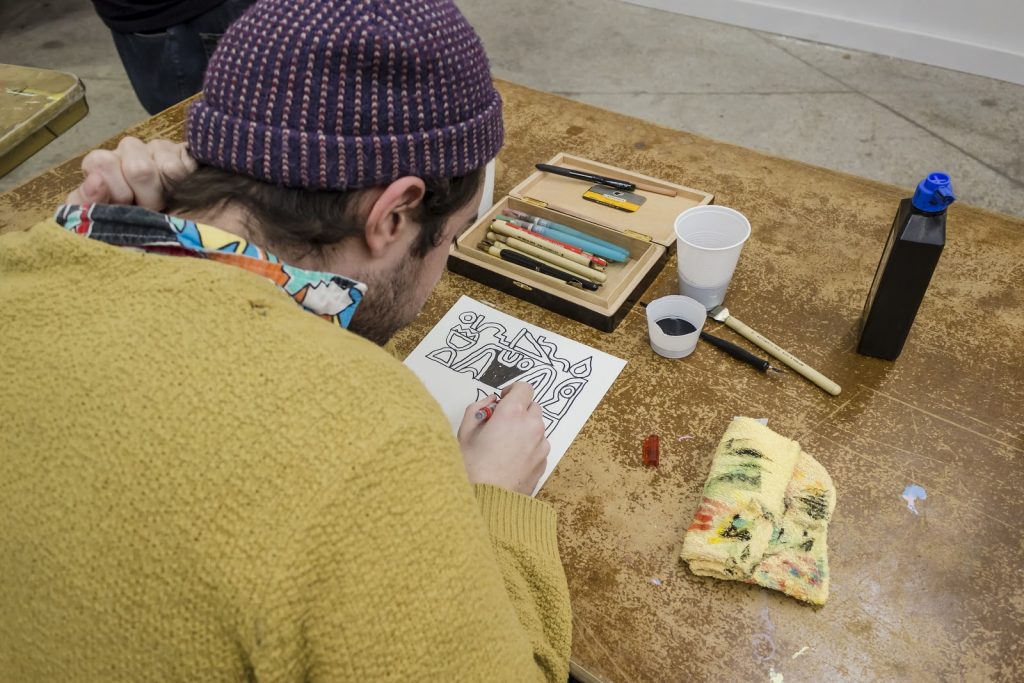Category: Program Report
Existing on the Periphery
Text by Centre for Arts & Social Practice
The Centre for Art and Social Practice reports from Kolkata, India with a project by Anuradha Pathak, in collaboration with Chander Haat and the Shelter Promotion Council.

EXISTING ON THE PERIPHERY
Sarsuna Theke Jana / Derives from the Metropolis
Public Art Festival | Sarsuna | Kolkata, India
June 1-10, 2016
In collaboration with Chander Haat & Shelter Promotion Council, India.
A community based art project developed by Anuradha Pathak (CASP-Kolkata), Existing on the Periphery dealt with the migration history of a community involved with the trade of selling puchkas, a famous street food of Kolkata. The project developed through various site visits to Phuchkapara at Khudirampally in Sarsuna, a village in South West Kolkata. This area is a marshy land very close to the Sunderbans, and has a history of migrants from Bangladesh who settled here around the Bangladesh Liberation War.
Phuchka is made famous by migrant communities from Bihar, Jharkhand and Uttar Pradesh. A small group of Puchkawallas (around 4 families) reside in Puchkapara and continue this generational trade, while others have shifted to alternate professions. Through several interactions, Pathak engaged with their migrant histories and their experience of place and belonging. The four families at Phuchkapara, are from the Nabada Zila in Bihar, but from different villages. They felt despite being residents of that area for around 20 years, they were not given importance like the immigrants from Bangladesh, presenting a complex layer to the discourse of migration in Bengal.
Questions of economics and livelihood emerged along with their daily experiences of selling puchkas in the glass and wood box on a mobile cart. Design ideas emerged from the families to make the box more convenient and user friendly. Pathak improvised the traditional box design by making the box bigger for containing the puchkas and added two small wooden boxes with three compartments each to hold the six accompanying ingredients. All the six compartments had six bowls to hold the ingredients. This refurbished box became a part of the participatory installation at the courtyard of the Mittir Bari, the house of one of the rich traders in Sarsuna. The installation was meant to symbolize the economic binary existing in Sarsuna and the marginalized position of the phuchkawalas in society.
The interactivity with the four families was transferred as text excerpts on the box, and the bowls had actual ingredients covered with text that underlined their health benefits. After the display, the box was returned to the community as a replicable design model and future projects with the women and families of this community are in discussion.











Transformative Change: The Summit at the Rauschenberg Residency
Text by Madeline Gallucci
Madeline Gallucci reports from The Summit at the Rauschenberg Residency as co-director of Front/Space, a DIY art gallery in Kansas City, MO. Madeline’s weekly reports are part of a large project called Program Report, collecting writing from art spaces around the world that focus on creating accessible, socially engaged programs for the communities the reside within.
Transformative Change: The Summit at the Rauschenberg Residency
Every year, approximately 70 artists, activists, and organizers from all over the country convene in Captiva, FL to attend The Summit hosted by the Robert Rauschenberg Foundation. Each of these organizations received a three year installment of a $10,000 SEED Grant, nominated anonymously, to use to continue their practice, fund operations, launch fundraisers, and special projects. Front/Space received the SEED Grant in late 2012 which further legitimized and funded the work of this small DIY project space. In 2014, Kendell and I attended our first Summit nearly one month after we assumed the new title of Co-Directors. In addition to these SEED Grantees, we share the honor of attending the conference with the 2015 and 2016 Artist as Activist Fellows. These fellows are given the opportunity to develop a project relating to social justice at The Rauschenberg Residency.
Our fellow SEED Grantees are from similar mid-sized cities that are experiencing cultural growth like Kansas City. These regions include Detroit, Buffalo, Cleveland, Phoenix, Atlanta, Boise, Santa Fe, Providence, Houston, Portland, Appalachia and New Orleans. Although each organization spans different media and content (from theater to performance, non-profit to DIY) as well as stages of growth and longevity, our common thread and mission is to advance cultural labor and develop innovative work.
The Summit, like other conferences, brings in speakers and special guests to touch on common topics and challenges each organization is dealing with such as Governance, Cyber Security and Fundraising. Unlike other conferences, this intensive week of group activities and deep listening highlights the connections between these cities through intensive peer-to-peer learning. Rather than solely relying on “experts” in the field, we use each other as our greatest resource, sharing specific strategies and personal experiences. The Rauschenberg Residency campus is the ideal location for this kind of group thinking. On an island with limited distractions, we spend the week together in both work and play and develop strong bonds that further build our communities.
Now, after our third and final Summit, I think back on Front/Space’s experience over these last 3 years. Since this magical time in Captiva is critical to the growth of all these organizations I want to extend some questions to consider from Vision Change Win. I hope these questions bring an insightful and introspective look into the operations of your organization to better understand and formalize your mission and vision:
What is your work?
What are your values and structure?
How do you grow your vision?
What are your top three things you are grappling with?
What resources do you HAVE?
What resources do you NEED?
Who is supporting you?
What additional support do you NEED?
How do you recruit support?
How are decisions made?
What is the financial cost of your work?
How is this work currently funded?
What opportunities or barriers does your current structure provide to generate funds to support the work?
Based on the answers to these questions… consider what other structures could address some of the items raised and how do they align with your values?What ways can you maximize and deepen your current structure?
What steps will you take to continue to identify, build and implement a structure that might benefit your organization and work?
Some mantras to consider:
We need TRUST to begin COLLABORATION and we need COLLABORATION to move FORWARD.
Notice the power of “YES!”
Yes to PROCESS.
Practice VUCA: Vulnerability, Uncertainty, Complexity, Ambiguity
Move away from Obligation and move forward to Inspiration, move away from Transaction and move forward to Transformation.
A complete list of SEED Grantees as well as Artist as Activist Fellows can be found here:
http://www.rauschenbergfoundation.org/grants/art-grants/seed
http://www.rauschenbergfoundation.org/grants/artist-as-activist-fellows

Kendell Harbin from Front/Space in our Peer Consultancy group with fellow SEED Grantees Cattle Track (Phoenix, AZ) and ELAB (Buffalo, NY).
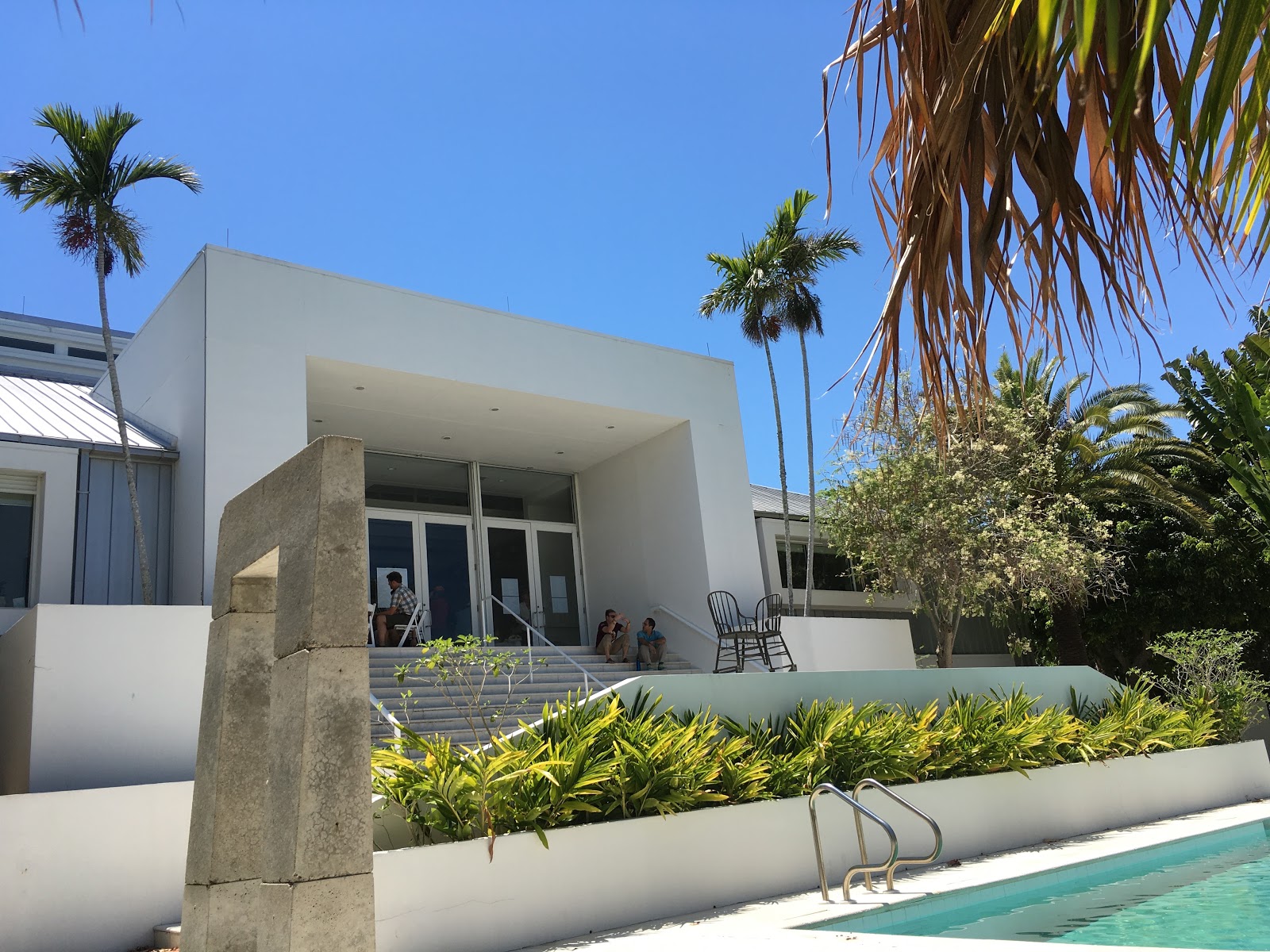
The Rauschenberg Residency is the former studio of the artist Robert Rauschenberg where he spent nearly 40 years making work.

Speaker Caroline Woodlard explaining the Solidarity Economy.

Time for relaxation is also a time for connection.

Facilitator Gibran Rivera inviting the group to explore the paradigm shift.
Front/Space: Exhibitions and Programming
Text by Madeline Gallucci
Exhibitions & Programming: Utilizing space in non-conventional methods
As we wrap up our Open Call for 2017, exhibitions plotted on a calendar and studio visits scheduled, we look forward to a robust year of programming featuring artists, performers and cultural workers spanning across many disciplines. This year, our call specifically emphasized proposals that were from people of color, low-income individuals, immigrants, sex workers, folks living in rural areas, Muslims, youth, people with disabilities, women, GNC and LGBTQIA+ people, as direct action against the results of the election and current administration.
Our Open Call process consists of gathering proposals over a two month period and then distributing them to a Review Collective, a 8-12 person panel, consisting of past artists who have exhibited at Front/Space. We see this as a way to create a platform that is driven not by the vision of two co-directors, but a way to generate input from those who have experience with the space, understand our audience and can envision the project coming to fruition in the small but mighty project space. We are still exploring methods of inclusion in this process and understand there are still biases that exist in choosing the work, however, as one of the only remaining DIY spaces in the Crossroads Arts District, it is a way to keep Front/Space community driven. Once the proposals are chosen, my collaborator Kendell Harbin and I, schedule the exhibitions and work on the logistics. We strive to create autonomy and confidence in each individual’s process, guide artists in directions not fully explored, create access to new partnerships and audiences. This assistance can span from installation and hardware consultation, material collection, sponsorship solicitation and/or conceptual actualization.
Front/Space has been long identified as a place for experimentation and risk taking. Due to the unusual architecture of the space, many individuals respond with site-specific work or work that is not quite fully realized that can be best executed in a non-traditional gallery context. One of the greatest defining features of Front/Space are the windows, which creates many unique relationships between inside and outside viewers during openings or performances. Many artists use the windows as part of the work utilizing projection screens, painting, or even harnessing the power of the sun.
Often the scope of projects proposed go beyond the size of the space and some artists choose to use Front/Space as a launching point to other locations in Kansas City. As exemplified through Rail Sail and Floodplain Buyout (see below), Front/Space was utilized as a type of “visitor center” or a gathering place to then be transported to the site where the physical manifestation of the project would take place.
As we look forward to the next round of exhibitions, I want to reflect on a some of the exhibitions that showcase what we strive for in a proposal. This way, to someone who has never visited Front/Space, can understand the spectrum of experimentation that happens in this small storefront. For more examples of past exhibitions please visit frontspace.info

Architectural model of Front/Space.

The ensemble SOLLUS, founded in 2015 by Rev. William Ellis Bradley and consisting of Joey Watson and J Ashley Miller, employed The Reverend’s solar-powered flutes (sollusflutes) as a means to emphasize the universal language of waveforms through long-tone compositions based on the orbital patterns of our solar system.

 Practical Optics by Caitlin Horsmon transformed Front/Space into a camera obscura, an optical device that creates a projection of the outside world directly into a darkened room using the sun as a light source and a pinhole on the window to create the image.
Practical Optics by Caitlin Horsmon transformed Front/Space into a camera obscura, an optical device that creates a projection of the outside world directly into a darkened room using the sun as a light source and a pinhole on the window to create the image.

Zanzibar Dior teaches you how to Time Travel by Ariel Abrahams explored time travel using simple activities such as jumping in place, conversing with a stranger, or screaming out loud to examine the expansion and contraction of time.

She Was Right: a Museum of Strange Archaeology by Erin Zona was dedicated to an experience of revelation, desire, and truth. This temporary institution’s exhibit featured works on paper, objects, and programming, presented in full museum spectacle. Through museum simulation, this show questions the hierarchies of authenticity and alters our notions of time, fact, and fantasy. Much like the exclamation “Eureka!” the phrase “She was right!” is meant to be associated with an act of discovery.

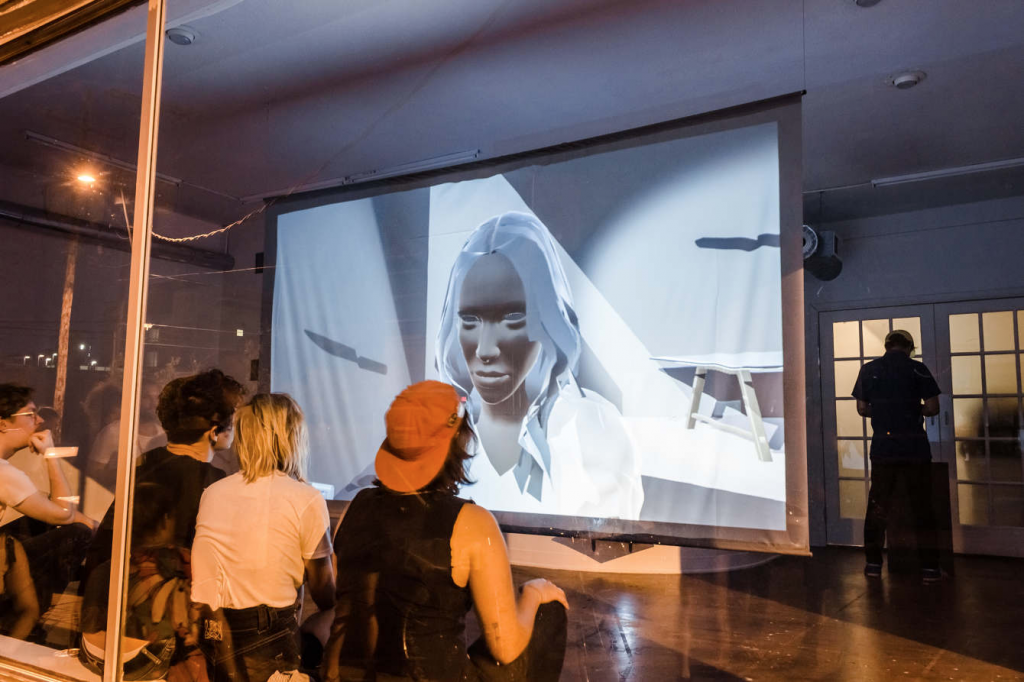 Are You Sure featured two new works by Ryan Kuo examining contemporary displacement. Nouns is an installation aimed at the Front/Space storefront window and inspired by the paintings of Edward Hopper and Giorgio de Chirico, in which bodies are petrified in self-examination by virtual light. The screen projects a videogame space that cycles between night and day in accelerated real-time, while multiple cameras work indefinitely to piece together a cheap 3D illusion, like a MakerBot or a wedding cake. File is a process work that speculates on the place of the artist (and everybody else) in the era of mobile studios and virtual workspaces. At its center is a hypertext essay multitasking as technical documentation for the File, a collaborative wiki for the team building the File, and a todo app that builds and releases anticipation for the always-imminent deployment of the File. The File asks the user to file the file in the file, and wonders, “How does one file oneself?”
Are You Sure featured two new works by Ryan Kuo examining contemporary displacement. Nouns is an installation aimed at the Front/Space storefront window and inspired by the paintings of Edward Hopper and Giorgio de Chirico, in which bodies are petrified in self-examination by virtual light. The screen projects a videogame space that cycles between night and day in accelerated real-time, while multiple cameras work indefinitely to piece together a cheap 3D illusion, like a MakerBot or a wedding cake. File is a process work that speculates on the place of the artist (and everybody else) in the era of mobile studios and virtual workspaces. At its center is a hypertext essay multitasking as technical documentation for the File, a collaborative wiki for the team building the File, and a todo app that builds and releases anticipation for the always-imminent deployment of the File. The File asks the user to file the file in the file, and wonders, “How does one file oneself?”

The Rail Sail by Joe Riley, Audrey Snyder and Ricki Dwyer, was a journey which deploys the imagery of wind, sea, and sail within the context of a post-industrial landscape of Kansas City. A wind-powered railroad vehicle connected urban and rural concourses, guided by chance and desire rather than reason or economy.

Floodplain Buyout by Timothy Amundson. Floodplain Buyout was an exhibition materialized through a series of an interactive experiences hosted by Front/Space and organized by the Turkey Creek Institute of Phenomenal Awareness (TCIPA). The exhibition utilized various artistic approaches including photographic based sculptures and an immersive sound installation to render abstract observations regarding the cultural, ontological, environmental, and spiritual conditions of Turkey Creek.
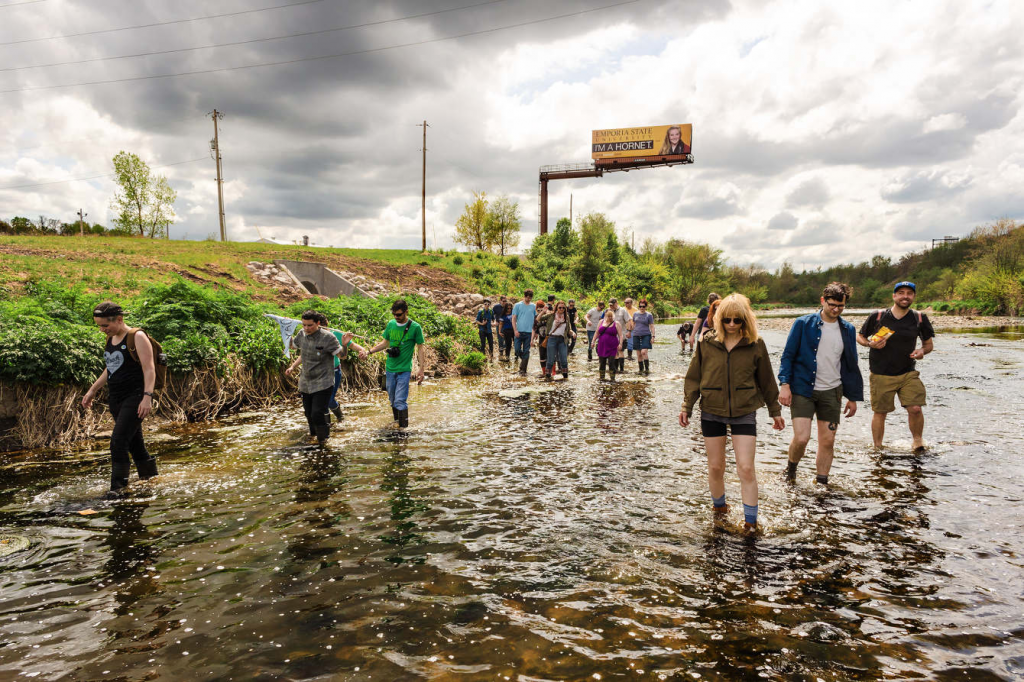
TCIPA also regularly opened a portal in Front/Space through which to transport participants to any number of undisclosed locations within the Turkey Creek watershed. This portal was activated over 50 times throughout the course of the exhibition, inviting viewers into personal and shared quests as a way of re-imagining relationships between commerce, development, architecture, land-use, and self. The way we see the city when we drive around in cars, and go into stores, and follow the directions our phones tell us to, was to be decidedly different along the creek.
CASP: Begumpur Community Engagement Program
Text by Centre for Arts & Social Practice

CASP – Begumpur Community Engagement Program (C-BCEP) is an initiative in New Delhi which focuses on the community histories and cultural practices of this urban village, while facilitating art education workshops. The Begumpur Balwadi is housed in a two storey Basti Vikas Kendra building which is the property of Delhi Development Authority. Children and young adults follow a non-formal curriculum and are imparted training in tailoring, computer, and other soft skills. Over the last 23 years, the Balwadi program has benefited the community through a range of summer workshops and educational camps. C-BCEP collaborates with the Balwadi program to run transdisciplinary workshops for practice-led thinking, artistic ideas and open knowledge.


Two artists, Nilanjana Nandy and Anni Sharan, facilitated two workshops in the Basti Vikas Kendra, focusing on questions of gender through popular representations in children’s books, fairytales and everyday objects.
1. Little Mermaid Project | Nilanjana Nandy | Age Group of Children: 5-8 years and 9-12 years / 2 days
This workshop involved representations of a mermaid in children’s books and fairytales. The children identified this half-human/animal representation as Jalpari (Hindi word for water fairy). Through simple indirect means and play, the children were induced to draw representations of Jalpari and articulate on the connections between the word and drawn image. Consisting of both young boys and girls, the workshop gently introduced conceptions of gender and fantasy, while allowing them to discuss colour, form, postures and sea life. Examples of this hybrid female form from Indian classical and folk art were shown to introduce visual examples through art history – Matsya Avatara (Lord Vishnu in Indian temple sculptures) and Matsakanya (Madhubani folk art).
2. Gendered Objects Project | Anni Sharan | Age Group of Children: 13 -16 years / 2 days
The workshop explored questions about everyday objects in daily life and how they develop gendered attributes. Through visualization exercises and collection of found objects, the discussion involved storytelling in Hindi and to identify five gendered objects through doodling, drawing and text. The second level (Me and my Object) was photographing each child with their own found object which they consider masculine or feminine. The third level involved a walk in the informal neighbourhood headed by a volunteer. This was a visual tour of the urban village and involved making quick sketches, scribbles and notes of the urban markers of development and makeshift housing, while locating attributes of gendered objects in the public space.
These community based workshops was organized by CASP – New Delhi chapter from June 26-29, 2015





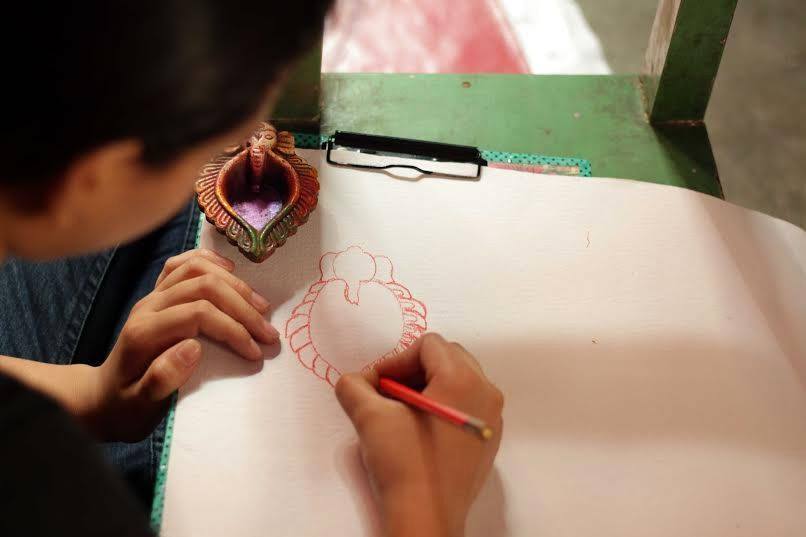

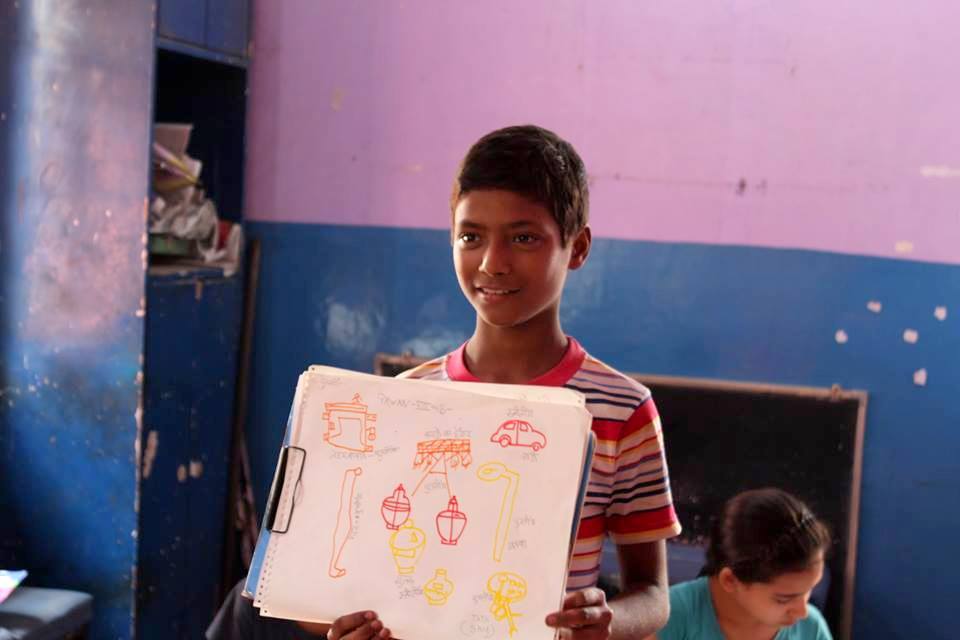

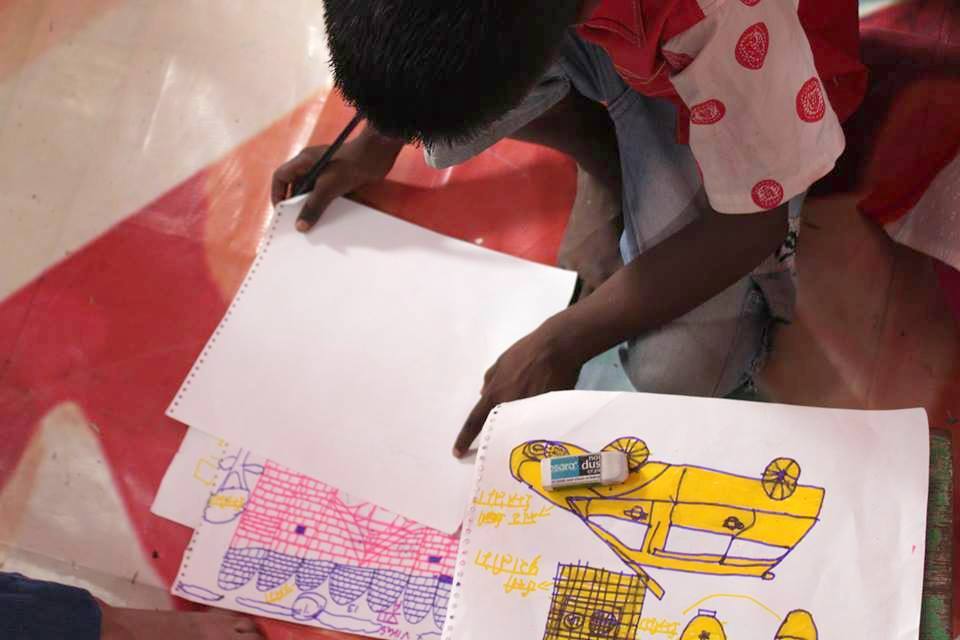

PSST: Prison Pipeline Radio
Text by Portland State Social Practice Talks
Our final conversation for our series focussing on mass incarceration welcomes Emma Lugo and Doug McVay, two of the producers of Prison Pipeline Radio.
The full conversation can be heard here.
For more information about Prison Pipeline, check out their page on the KBOO website. You can listen on KBOO every Monday from 6:30-7:00pm.
PSST: Francesca Piantadosi
Text by Portland State Social Practice Talks
Our PSST conversation from February 21st welcomed Francesca Piantadosi to talk about her work teaching playwriting in Prisons.
You can listen to the full talk here.
Francesca Piantadosi (Playwright Instructor) is an award winning playwright who hails from Portland, Oregon. She’s been a participant at Seven Devils Paywriting Conference; a Finalist for the Rosenthal New Play Prize, Seattle Rep’s New Work Festival, Ojai Playwriting Festival, Orlando Shakespeare Festival, JAW, New Harmony Project, Play Labs (Playwright’s Center Minneapolis) and has had productions from Bangalore, India to New York.
For the past three years she’s been teaching playwriting (a program she started) at MacLaren Correctional Facility (which serves men age fourteen to twenty six.)
MoMAZoZo: An Interview With Paula Wilson and Mike Lagg
Text by Spencer Byrne-Seres
Carrizozo is a small railroad town in southern New Mexico surrounded by mountains to the East and White Sands Missile Range to the West. I visited there last December and was fortunate to meet Paula Wilson and Mike Lagg, the founders of MoMAZoZo, an art space located in Downtown Carrizozo. Mike and Paula have been developing a residency program over the past several years to bring artists to Carrizozo, where they can find both solitude and engagement with the community, history, and landscape of South Central New Mexico. The following interviews looks into the history and future of MoMAZoZo, and the dynamics of art spaces in small towns. It also offers a glimpse into how artists are incorporating structures from art institutions, such as that of a residency, into their own practices.
Spencer: First, I’d love to get a little background and timeline for MoMAZoZo. How and when did it get going as an art space and as a residency? Were you following a specific vision in establishing it, or working intuitively as things progressed?
Paula: Mike and I remember how MoMAZoZo began differently. I have a distinct memory of Mike coming up with the name in my studio while I was painting. It clicked– funny yet somehow accurate. Kind of like, let’s dream big and fill those shoes. It was more of an idea than a program, institution, or plan of action. It was about us joining forces. We aren’t married but have been together for 10 years, so it represents our union– our idea, our coming into being and the meeting of our minds and artistry. I made a poster for MoMAZoZo. A picture of a cube in the desert or an empty blank space. That was the start for me.
Mike: What I remember is that we were offered a free space on 12th Street in Carrizozo. Large, abandoned, and unencumbered. We proceeded to it make it MoMAZoZo. We made signs, we made pretzels, we made it a space to be visible. The MoMAZoZo hour is what made it possible.
Paula: Our open hours have been consistent and unwavering from the start– Fridays, from noon to one.
Mike: Except we are closed on Black Fridays for humanity’s insanity.
Spencer: How did each of you come to Carrizozo? What prompted you to stay?
Mike: Paula came here for the promise of a green chili cheese burger. I came here because of the cheap rent and I saw the opportunity of Carrizozo to be my art center.
Paula: Yeah. I was living in Brooklyn, making art and teaching. I became familiar with the area because my Mom had moved to Lincoln, NM, which is about 45 minutes from Carrizozo. I always loved being in New Mexico and spent as much time as possible here. I hooked up with Mike while I was visiting her and we were long distance lovers for a year before I saw a chance to leap into this new life. It seemed so full of possibility and a means to be fully in my artistic life. And then there is the green chili addiction…
Spencer: I’ve been thinking a lot about my experience traveling down to Carrizozo. It’s a very specific experience, much like traveling to Marfa, or visiting Spiral Jetty: each highway, turn and small town you pass through adds to the meaning of the place you wind up. But that is my experience as an outsider, coming from an urban center. I think there is this urban-center/rural-periphery divide that dominates many narratives of the art landscape and privileges cities over small towns. What has been your experience of working in a rural town? Does this distinction hold up? Does MoMAZoZo operate as a periphery or a center?
Paula: MoMAZoZo is definitely a center in the new global and virtual paradigm.
Mike: It wasn’t until recently until we physically became the center of the art scene in Carrizozo with the purchase of the Lyric Complexu on Twelfth Street. It was an abandoned suite of buildings. Two of them were on the verge of being condemned. The third one, being Paula’s studio, was recently remodeled for a micro brewery. Included in this complexu are ten lots of open space. It is across from a park that is basically the center of Carrizozo with Twelfth street being the historic and artistic biway. So all told we have a 5,000 square foot studio and a two story abandoned hotel with lots of potential.
Paula: Not to mention the Lyric Theater. I like how you talk about the experience of traveling here. We find ourselves at the spot near where White Sand National Monument meets the Valley of Fires lava flow. There is a tension of forces that give Carrizozo its vitality. A mix of liberals and conservatives, newcomers and old timers, preservationists and cattle ranchers.

Spencer: I was struck by Paula’s comment that as visitors we sort of functioned like currency. I reflected on how laid bare a lot of transaction is in small communities: visitors bring income or extend networks or increase visibility. These transactions are not always so transparent in large cities, and aren’t necessarily intuitive either. Starting a residency seems like a good way to foster transaction and serve both artists and communities. What has been your experience so far running the residency? What have been some of the experiences of participants?
Mike: We found that the residents of Carrizozo have embraced our Artists-in-Residences with open arms.
Paula: It is the simple things, like when Sully volunteered to take Jemima back to the airport, or when Anya was able to procure bicycle tire tubes from Bill at the municipal airport. The need arrived and was satisfied without the exchange of dollars but just with good will. In Carrizozo we can privilege quality and diversity of human interaction.
Mike: The other day someone asked– “When is OUR next Artists-in-Residence coming?”
Paula: Yay. I wasn’t quite expecting the community to have such a stake and investment in our artist’s experience. And there is a reverberating impact that each visitor and artist has– recommending and bringing new people to the area… a network. The Carrizozo Colony AiR is a collaboration with Joan & Warren Malkerson. They provide the housing and studio spaces. We work together to make this thing sustainable and smooth operating.
Mike: There is a community email newsletter and each artist has been getting a profile in the local paper. It is just the way small communities work and we try not to take it for granted.
Spencer: What has been your experience as partners and collaborators? As two artists with individual practices, a collaborative practice, AND an art space and residency that you run together, I’m always curious about process…
Mike: In most things, that an artist does, you basically are doing by yourself, because that is just the nature of the artist’s life. So when an opportunity does come along to collaborate, that is a special moment. Those are the rare occasions that you gotta jump on. Because two people working together have the exponential power of creative force.
Paula: Yes, I like it. I think it is hard for us to see how often and successfully we collaborate. I tend to focus on the production…
Mike: … but that is really not that important sometimes.
Paula: Right. We live and work together, the parsley in our garden, the painting on our kitchen cabinets, the flat files that you made… it is in the grown and digested life that fuses us. There are plenty instances of manifestation of our collaborations, like our workshops and…
Mike: … our wooden spoons.
Spencer: Looking forward, what is on the horizon?
Paula: We have been blessed by support both within and outside of Carrizozo. Currently a New York collector of mine, who visited and loved Carrizozo, is funding an Executive Director position. We are welcoming 13 artists in 2017 for the Carrizozo Colony Artist-in-Residence. We look forward to hosting lots of events in the Lyric Theater.
Mike: So far I have been tearing down the fences along our new properties. I look forward to more openings, more access, and more diverse collaborations.
Paula: Yes! And visitors. Please come visit us.
To visit: LYRIC COMPLEXU on Twelfth St in downtown Carrizozo 503 12th St, Carrizozo, NM, 88301. The MoMAZoZo hour happens every Friday from 12pm-1pm.
Contact: info@momazozo.com
PSST: Joshua Safran
Text by Portland State Social Practice Talks

Joshua Safran talks about his ongoing work as a lawyer advocating for the wrongly imprisoned and survivors of domestic abuse, and the film Crime After Crime.
The full podcast can be heard here.
For its second season of public conversations, the Portland State Social Practice Talks public conversation series has focused on various aspects of the prison-industrial complex in the United States. These talks have ranged from artists to reform advocates, playwrights to curators, all engaging with, challenging, and questioning the role of prisons in our society. The conversations serve as a form of public research in relation to an ongoing project at the Columbia River Correctional Institution. The goal is learning how different people approach contact with the corrections system, and the potential role of art in this context. The conversations were held publicly at the Portland Institute for Contemporary Art.
Program Report: Front/Space
Text by Madeline Gallucci
Sustainability: Molding a Fundraiser
Becoming a sustainable organization, especially at the DIY level, is something constantly in balance at Front/Space. Over the last two and a half years, we have experienced unprecedented growth which has challenged the way Kendell and I look at finances in our small volunteer run organization. It may seem hard to believe, but our operating budget for the year is close to $18,000. With rent as our largest expense, we constantly come back to our core question: How can we serve artists and pay them for their creative labor?
We strive to provide support by the means of stipends to in-town and out-of-town artists, as well as paying a photographer to document our exhibitions. With these expenses being the foundation of our budget, we realized that we would need a variety of funding sources to close the gap between our grant from the Robert Rauschenberg Foundation and operating expenses. With multiple consultations with a variety of community partners, we decided to look into fundraising models created by similar sized DIY organizations.
We landed on the idea for Hot Hands, a live drawing and fundraising event, because we saw it as an opportunity to showcase a distilled version of our goals as a whole for Front/Space. Hot Hands is centered around a very simple format of promoting artists. One night only, artists make their work on the spot that can be purchased for a flat rate of $30.
Each artists tackles this challenge in a different way, forging new ways of thinking in their personal studio practice. We quickly realized how democratic the event can be for both those who are participating or attending. The $30 price point makes the art work extremely accessible, “leveling the playing field” between emerging and established artists. Whether you are a first time collector or a savvy buyer, anyone can witness the magic of an artwork’s creation from the artists’ hands to the finished piece on the wall.
Below are a few tips and tricks, if you choose to create your own Hot Hands or to be applied to your own fundraising model:
- Establish your venue. This will assist in knowing the capacity for your event.
- Form a budget that seems reasonable to fit within that venue. For instance, if your goal is to raise $10,000 but your space’s capacity is 150 people, perhaps you need to partner with another larger organization with enough space to host your event.
- Establish your artist roster. Who will be participating? Be sure it is a mix of well known artists in the community as well as emerging artists who are looking for opportunities. Outline the event to the artists and make sure they are a good fit. Many might be nervous about crowds or making work on the spot.
- Establish a Volunteer Coordinator and gather volunteers. Communicate your expectations to the Volunteer Coordinator and make sure they understand the multiple roles that need to be filled such as the register, greeting guests, runners, art handlers, set up and break down, etc. Do not forget to make your volunteers feel appreciated!
- Solicit Donations. Ask ask ask! You never know if someone will donate until you ask. Soliciting alcohol donations to be then distributed (not sold) is helpful and tips can be a large source of income for the event.
- Communicate with your artists and establish a meet and greet so they can get to know each other. It is also helpful to have your volunteers meet the artists before hand so they can accurately promote and advocate the artist’s work and help answer any questions to guests.
- Establish a system for taking money. Since Front/Space has a parent organization as our fiscal sponsor (Fractured Atlas) we had to conform to a couple of rules set in place by them. Determine if you will take sales with cash and/or card.
- Merch! A commemorative t-shirt or tote bag (if marketed correctly) can go a long way but also do not forget to do a non-specific-to-the-event merch item as well. That way if you do not sell out of the t-shirts that say “Hot Hands 2017” you can use them for other fundraising opportunities or sell them throughout the year.
- Understand your audience. Figuring out who you are targeting to attend your event. Most people who are excited to spend $30 on a piece of artwork (a steal!) will not pay a $20 admission cover. Understanding who you are throwing this event for will contribute to its success.
- Follow up! Thank you cards, emails, whatever it takes. Be sure to follow up with your audience, volunteers and artists after the event to be sure everyone knows that without their support this event (and your organization!) is not possible.
For more information about Hot Hands please view this article written by KCUR : http://kcur.org/post/hot-hands-pulls-back-curtain-artistic-process-annual-fundraiser#stream/0

Program Report: CASP
Text by Anuradha Pathak
The Centre for Arts & Social Practice introduces a project from 2015 that involved a notebook exchange and creation of a large collaborative rug.
Navi Mumbai l Kolkata l Pune l New Delhi
Derdh Guna Derdh | (one and half by one and half)
Community based art project by Anuradha Pathak | Installation Artist & Head – Kolkata Chapter
The community based art project Derdh Guna Derdh was developed at Shankar Camp in Vasant Kunj, New Delhi. The people living in this area are rural migrants from Sunderbans – West Bengal, Jharkhand, Bihar and Uttar Pradesh and their basic occupation is as house-helps of the residents living in Vasant Kunj area. These people live in an urban cluster with impermanent housing and civic facilities, and share diverse religious and cultural practices. The project developed through dialogues with the women of Shankar Camp who brought forth issues of migration and belonging, amidst the economic need to live in the city. The memories of domestic craft and recycling of textiles became the context through which this project was implemented in two main activities:
1. Documenting the Daily: There is a long standing practice of women in India from marginalized communities to buy household items in exchange of old clothes. Here the notebooks and pen/pencil were provided in exchange for clothes to make the 1.5 x 1.5 ft Aasans (cloth rugs). The notebooks were used as diaries by the children in that area where they documented their daily experiences and aspirations for three months.
2. Mark on the Plot: Aasans (small cloth rugs) are generally used in rural areas where they are spread on the floor for people to sit on. In this workshop, aasans, with a size of 1.5 x 1.5 ft were made from the worn-out clothes (sarees and dupattas) by the women in the community. These old clothes were exchanged first with the note-books/pencils and then each woman was given colourful cloths of the exact size along with a white small cloth on which they wrote an unfulfilled desire or an issue plaguing their living spaces in Shankar Camp. After this, they did needle-work on the writings and stitched them on their respective aasans. They also decorated the aasans with colourful beads and patterns. When each 1.5 x 1.5 ft cloth was complete, all the cloths were joined together to form a big rug.
Derdh Guna Derdh (one and half x one and half) was conceptualized and facilitated by Anuradha Pathak (installation artist, Kolkata) and supported by Parul Kiri Roy (architect-academic) and assisted by an architecture student, Michael Vivian Ekka. The community based art project workshop was organized by CASP – New Delhi chapter from 30 March – 2 April, 2015

